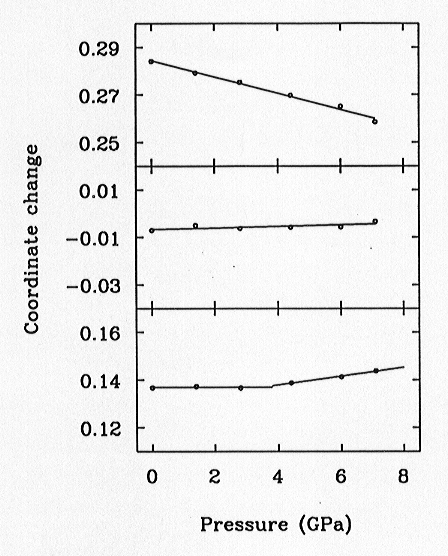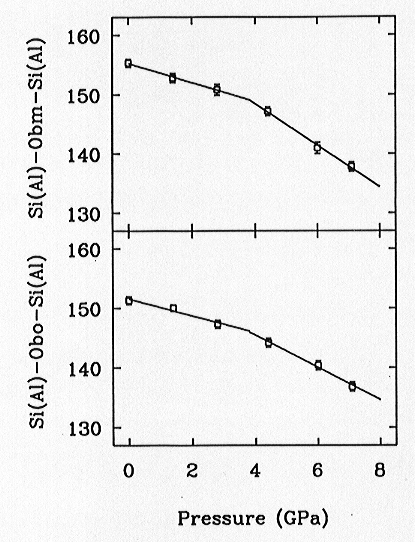

Members of the feldspar group of minerals are the most abundant constituents of igneous rocks and form a major component of the Earth's crust. The ubiquity of the feldspars along with their wide range of composition has led to their use as the principal means of classifying igneous rocks and also makes a knowledge of their high-pressure and high-temperature behaviour crucially important for the understanding of the chemical and thermodynamic processes occurring within the lithosphere. Towards this end we have conducted a series of high-pressure single-crystal X-ray diffraction studies of selected feldspar minerals and have recently identified a change in compressional behaviour of well-ordered K-rich microcline.
In order to obtain single crystals of reasonable quality for these experiments, despite the cross-hatched twinning present in microclines, samples of amazonite were used which contain < 1wt% of Pb and tend to have twin domains on the order of 1 mm. Unit-cell parameters of samples cut from untwinned regions of these crystals indicate that a degree of residual strain is present but, nevertheless, they display sharp and unsplit X-ray diffraction peaks unlike crystals from many other microcline samples. Previous studies of the compression of the unit cell have identified discontinuities in the pressure dependence of the α and ß angles at approximately 3.8 GPa while the pressure dependence of γ appears to be continuous. The volume reduction accompanying this change in behaviour was found to be too small to be measurable and studies conducted above ~ 3.8 GPa did not reveal a change in symmetry. We have now repeated these earlier unit cell measurements, but over a pressure range extended from ~ 4.8 GPa to ~ 7.1 GPa and we have also determined the underlying pressure-induced changes in the crystal structure for the first time. The preliminary results confirm the discontinuous behaviour of the pressure dependence of the unit-cell angles and also confirm that the space group symmetry of the microcline structure is unaltered above ~ 3.8 GPa.
Although further intensity data are required to fully complete the strutural
refinements, our initial results indicate that the structural changes with
pressure are remarkably strong. The potassium atom, for example, undergoes
a large shift with pressure which is principally confined to the (010)
plane (Fig. 3.3-2). The strongest component of the displacement is directed
along the a-axis although, perhaps more significantly, it is evident that
there is an abrupt change in the pressure dependence of the c-axis component
at a pressure close to 3.8 GPa. Accompanying the potassium atom displacement
there are some very large bond angle changes and, notably, the Si(Al)1o-Obo-Si(Al)2o
and Si(Al)1m-Obm-Si(Al)2m linking bond angles exhibit very large reductions
of about 15° and 18°
respectively (Fig. 3.3-3). Indeed, both bond angles also show distinct
changes in their pressure dependence at about 3.8 GPa which may partly
account for the discontinuity in the rate of change of the unit cell angle
ß at the same pressure. As the internal O-Si(Al)-O
bond angles of the Si(Al)O4 tetrahedra vary only slightly over
the pressure range studied, the large changes in the linking bond angles
appear to be due to relative tilting of the essentially rigid corner-sharing
tetrahedra - behaviour similar to that observed in other complex framework-type
crystal structures.
 |
 |
Fig. 3.3-2: The variation of the internal coordinates of the K-atom in microcline with pressure. |
Fig. 3.3-3: The variation of the Si(Al)1o-Obo-Si(Al)2o and Si(Al)1m-Obm-Si(Al)2m linking bond angles with pressure. |

Tel: +49-(0) 921 55 3700 / 3766, Fax: +49-(0) 921 55 3769, E-mail: bayerisches.geoinstitut(at)uni-bayreuth.de
 Previous page
Previous page